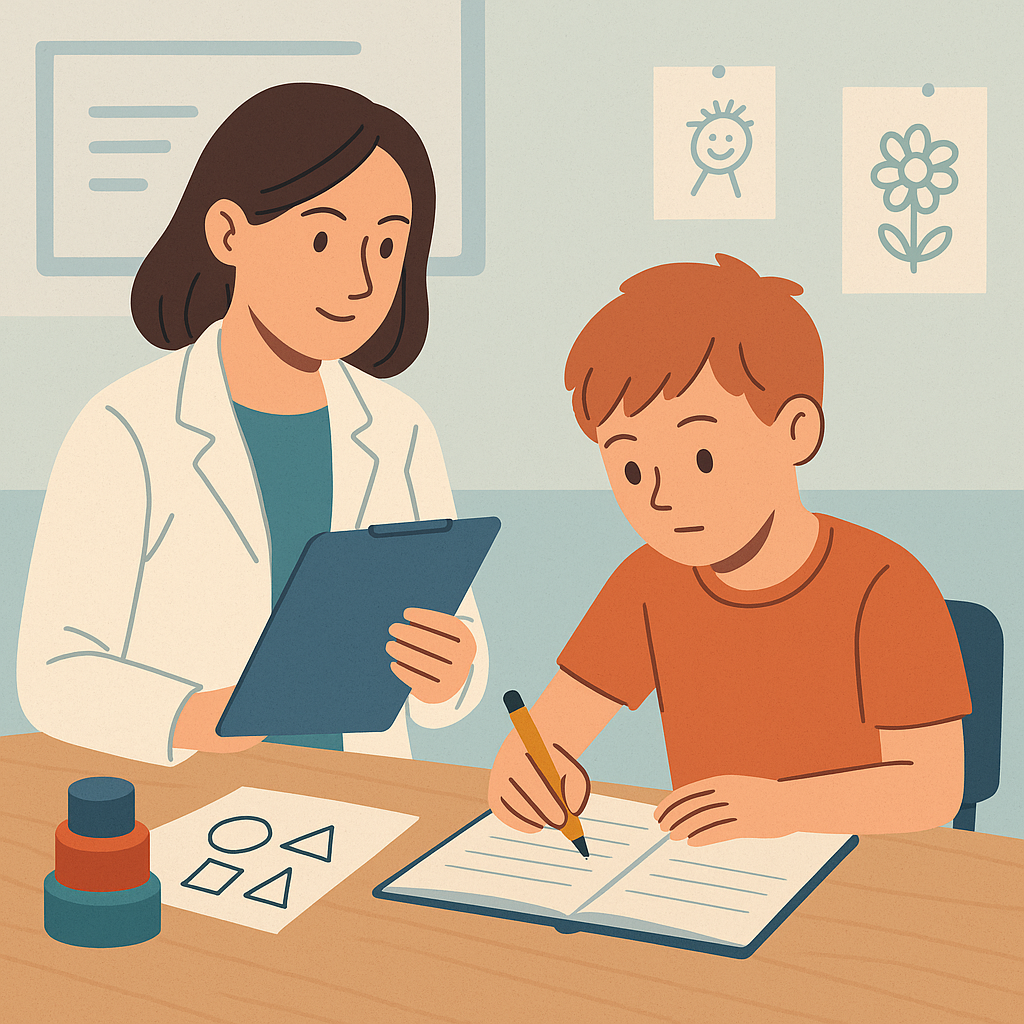
Early Signs of Learning Disorders Occupational Therapists Watch
Children develop at different rates—and occasional struggles are normal. However, when certain challenges persist or cluster across areas, they may hint at underlying learning disorders. Occupational therapists (OTs) are uniquely positioned to detect these early cues by observing how children manage everyday tasks like drawing, writing, organizing, and regulating behavior. Early detection gives families and professionals a chance to intervene before academic difficulties, frustration, and self‑esteem issues take root.
In this article, we explore the red flags OTs look for, organized by developmental domain. We also discuss when concern is warranted, how OTs assess these signs, and why early intervention matters. By recognizing early warning signals, caregivers, teachers, and therapists can work together to support children in reaching their potential.
Why Occupational Therapists Monitor for Learning Disorders Early
Occupational therapists focus on how children function in daily life—play, self‑care, school tasks, fine motor tasks, and sensory processing. Because many learning disorders manifest not just in academic ability but in how a child executes tasks, OTs often detect problems earlier than academic testing might.
Key reasons OTs are important in early detection:
- Functional observation: OTs see how children engage in real tasks—drawing, cutting, handwriting, copying, organizing materials—not just isolated tests.
- Integration of domains: OTs assess how motor, visual, sensory, and executive functions interact, which is often where breakdowns occur.
- Scaffolding potential: Through dynamic assessment, OTs can see how the child performs with supports (e.g., modified task or cues), indicating whether skills are emerging but constrained.
- Prevention of secondary effects: The earlier signs are addressed, the less likely a child develops avoidance behaviors, anxiety, or pervasive academic lag.
In short, OTs are often among the first professionals to flag possible learning challenges—especially when they arise from underlying motor, sensory, or organizational difficulties.
Key Domains and Early Warning Signs
Below are the primary developmental domains OTs monitor. For each, we describe typical red flags and how they might present in everyday contexts.
- Fine Motor Skills & Hand Use
Fine motor control is foundational for many school tasks (writing, cutting, manipulating small objects). Difficulties here often co-occur with learning disorders.
Red Flags:
- Difficulty with pencil grasp or holding writing instrument awkwardly
- Struggling to control the crayon or pencil, producing very light or heavy strokes
- Avoidance of coloring, drawing, or writing tasks
- Slow performance on fine motor tasks (e.g., bead threading, puzzles, manipulating small objects)
- Trouble using scissors, buttoning, zipping, tying shoelaces
- Fatigue or complaining of hand pain when writing
Children who avoid fine motor tasks may mask underlying difficulties. These signs often precede explicit writing challenges.
- Handwriting & Written Expression (Dysgraphia Indicators)
One of the most visible academic manifestations is in writing. Dysgraphia is a writing-specific learning difficulty affecting motor planning, orthographic coding, and written expression.
Red Flags:
- Slow, laborious, or effortful handwriting
- Inconsistent letter formation, size, slant, spacing, or baseline alignment
- Frequent erasures, revising, or hesitation
- Omitting letters, words or parts of words
- Poor planning or organization in written work
- Difficulty copying from board to paper (loss of place)
- Decline in legibility or speed when writing longer text
These challenges may be exacerbated by weak visual-motor integration or fine motor deficits.
- Visual-Motor Integration & Visual Perception
Reading, writing, and many academic tasks depend on coordinating vision and motor action. OTs look for how children interpret visual information and translate it into movement.
Red Flags:
- Trouble copying shapes, letters, or geometric designs
- Losing place while reading or writing lines
- Frequent skipping, repeating, or transposing words
- Letter reversals (e.g., b/d, p/q) beyond expected developmental phase
- Difficulty aligning numbers in math columns
- Poor spatial organization on a page
Visual processing difficulties may also show as challenges in distinguishing similar letters or managing cluttered visual fields.
- Sensory Processing & Self-Regulation
Some children with learning disorders also struggle with sensory processing or self-regulation, which can interfere with attention and task persistence.
Red Flags:
- Hypersensitivity or hyposensitivity to tactile, auditory, or visual stimuli
- Overreaction to noise, bright lights, textures, smells
- Frequent distraction, fidgeting, restlessness, or movement seeking
- Trouble sitting still during tasks
- Overwhelm or shutdown in busy or novel environments
- Difficulty transitioning between tasks
Sensory difficulties make focusing and processing academic material more taxing, compounding learning challenges.
- Executive Function, Planning & Organization
These higher-level cognitive skills are critical for sequencing tasks, organizing materials, managing time, and controlling impulses. Weaknesses here are often present in children with learning disorders, especially when academic demands increase.
Red Flags:
- Difficulty planning multi-step tasks (e.g. “first do A, then B, then C”)
- Omitting steps, reversing sequence, or getting “stuck” mid-task
- Poor organization of materials, desks, backpacks, and written work
- Trouble initiating tasks or frequently delaying
- Losing track of where they are in an assignment
- Working slowly or inefficiently
- Poor time management or underestimating time needed
Executive dysfunction can be subtle early on but becomes more visible as demands grow.
- Attention, Working Memory & Processing Speed
Low working memory, distractibility, or slow processing can impair learning. These issues might not always be primary, but OTs monitor how they affect task performance.
Red Flags:
- Frequently forgetting instructions within a few steps
- Needing repeated prompts or reminders
- Losing focus mid-task or switching tasks prematurely
- Slow performance even when a child understands the task
- Difficulty juggling multiple pieces of information
- Overreliance on external cues, reminders, or support
These signs may signal co-occurring conditions like ADHD or be integral to certain learning disorder profiles.
- Gross Motor Coordination
Although more indirectly related to academic tasks, gross motor challenges can point to developmental coordination disorders (DCD), which often co-occur with learning disorders.
Red Flags:
- Clumsiness, frequent tripping, bumping into objects
- Avoidance of playground tasks, sports, or physical games
- Poor balance, coordination, or delay in motor milestones
- Difficulty with ball skills, jumping, climbing, or catching
- Frustration in physical tasks or avoiding them altogether
These difficulties may correlate with motor planning or sensory issues affecting learning.
- Language, Oral-Motor & Communication Skills
Learning is deeply tied to language — both receptive and expressive — as well as the planning of speech. Some children with learning disorders have coexisting language or speech challenges.
Red Flags:
- Late onset of babbling or first words
- Limited vocabulary growth, difficulty producing complex sentences
- Trouble with rhyming, segmenting sounds, or phonological awareness
- Frequent mispronunciations, omissions, or articulation errors
- Difficulty following multi-step verbal instructions
- Trouble organizing spoken ideas or narrative structure
- Slurred or imprecise speech suggesting oral-motor planning issues (e.g. verbal apraxia)
Language challenges often amplify reading, spelling, and comprehension deficits downstream.
When Should Parents, Teachers, or Therapists Be Concerned?
Not every struggle is a learning disorder. Some variability is expected in development, but the red flags become more significant under certain conditions:
- Persistence: The difficulty is consistent over months and across settings (home, preschool, school)
- Interference: The problem impedes participation in age-appropriate tasks—play, schoolwork, self-care
- Discrepancy: The child’s performance is significantly below what would be expected for age, intelligence, or opportunity
- Multiple domains: Red flags appear in more than one developmental area (e.g. motor + organization + attention)
- Emotional impact: The child begins to avoid tasks, becomes frustrated, expresses low self-esteem or anxiety
If caregivers or teachers notice clusters of signs—especially at higher task demands—it’s appropriate to refer for evaluation.
How Occupational Therapists Evaluate These Signs
OTs use a combination of assessment strategies and evidence-based tools to confirm whether early red flags are meaningful. Below is an overview of typical steps in a pediatric OT evaluation for learning concerns:
- Referral & History Gathering
- Collect detailed developmental history: motor milestones, feeding, self-care, play
- Ask about family history of learning disorders or neurodevelopmental challenges
- Use questionnaires or rating scales (e.g. sensory profiles, fine motor checklists)
- Interview parents, teachers, and caregivers to gather observations across settings
- Observational Assessment & Task Analysis
- Observe the child in naturalistic tasks (drawing, cutting, play, writing)
- Break tasks down into subtasks to locate precisely where breakdowns occur
- Observe how the child approaches errors, self-corrects, or requests help
- Standardized & Norm-Referenced Tests
- Fine motor and manual dexterity tests
- Visual-motor integration assessments
- Handwriting or writing assessments
- Executive function or planning tests (where available)
- Sensory processing or perception tests
- Dynamic / Modified Task Approaches
- Provide scaffolding (verbal, visual, or tactile cues) to see how performance improves
- Adjust task difficulty or format to see latent capacity
- Test alternative strategies (e.g. keyboard vs handwriting)
- Collaboration with Other Professionals
- Work closely with speech and language therapy, neuropsychology, educational assessment teams
- Cross-reference findings on cognition, academic skills, speech/language function
- Synthesizing Findings & Recommendations
- Identify underlying difficulties and their functional impact
- Recommend individualized interventions, accommodations, or further diagnostic evaluation
- Educate caregivers and teachers about strategies to support learning
This multimodal evaluation helps the OT and the broader team understand why a child is struggling—not just that they are struggling—and supports targeted interventions.
Why Early Occupational Therapy Intervention Matters
Intervening early can alter a child’s learning trajectory. The earlier we address foundational difficulties, the greater the chance to:
- Build foundational skills (e.g. fine motor control, visual-motor integration, regulation)
- Prevent academic lag before it becomes entrenched
- Reduce frustration and avoidance behaviors that can lead to learned helplessness
- Boost confidence and motivation
- Empower environments (home, classroom) with accommodations and supports
OTs can help children gain strategies, compensatory skills, and environmental modifications to thrive in school.
Examples of OT support include:
- Handwriting instruction and alternative writing tools (e.g. pencil grips, slant boards, keyboarding)
- Visual-motor integration exercises
- Sensory regulation activities (e.g. sensory diets, proprioceptive input)
- Task breakdowns, checklists, visual scheduling
- Executive functioning coaching—chunking tasks, reinforcing planning, cueing
- Collaboration with teachers to modify assignment formats, using accommodations
- Training families in structured routines, cues, and scaffolding
With early and consistent support, many children show substantial improvement in functional and academic performance.
Sample Age‑by‑Age Red Flag Checklist
Here is a rough guideline of signs by age group that OTs and caregivers might monitor. Note: absence of all signs does not mean no issues; presence of multiple signs over time warrants evaluation.
| Age Range | Key Signs / Red Flags |
| 0–3 years | Delays in reaching fine motor milestones (e.g. grasp, manipulation); poor imitation of movements; limited use of toys; late or minimal babbling; difficulty with stacking or basic puzzles; extreme sensitivity to textures or handling |
| 3–5 years (preschool) | Avoidance of coloring, cutting; trouble with simple art tasks; difficulty playing with building toys; poor scissor use; trouble with rhyme or sound play; disorganization in play; frequent meltdowns in stimulating environments |
| 5–7 years (early school) | Illegible or slow writing; difficulty copying letters or shapes; losing place in reading or writing; skipping or reversing letters or words; trouble organizing work; forgetting instructions; cluttered desks; avoids writing or school tasks |
| 8–10 years | Persistent writing struggles, disorganized written work; slow work completion; difficulty planning multi-step assignments; trouble with math alignment or spatial math; difficulty summarizing or organizing thoughts; challenges in note-taking |
| 11+ years | Continued difficulty with written expression (essays, reports); poor time management, planning for long-term assignments; weak studying strategies; frustration or avoidance of academic tasks; lower grades in comparison to potential; lower self-confidence in academic settings |
This checklist is a general guide—each child is unique and profiles differ
Conclusion
Occupational therapists play a vital role in early detection of learning disorders by observing how children manage everyday tasks and learning demands. By tracking red flags across fine motor, visual-motor, sensory, executive, language, and behavior domains, OTs can surface hidden challenges before they become entrenched. Early, data-informed intervention helps children build foundational skills, reduces frustration, and enables more positive school experiences.
If you notice persistent challenges in your child or student—especially across multiple areas—it’s worth seeking a pediatric OT evaluation or consultation. At Haghighati Occupational Therapy Academy, we are committed to partnering with families, teachers, and children to design assessment and intervention plans that support each child’s strengths and needs.

